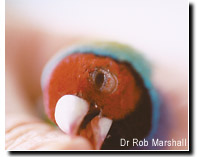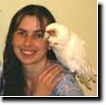

Chlamydia or Psittacosis
by Dr. Rob Marshall
Ornithosis is one of the most common infections in cage and aviary birds. Slow molt and lack of activity may be the only outward signs of Ornithosis in your birds. Ornithosis is a disease caused by the bacteria Chlamydia psittaci which lives and reproduces inside the living cells of birds.
The conclusion of the molt should herald an overflow of energy and vitality. When birds fail to come alive at the end of their molt, then one must consider the possibility that the demand of growing new feathers has exposed an underlying health or nutritional problem. Inactivity, a quiet bird room, dull feather color and a lack of sheen are signs that the molt has placed undue stress upon the flock. Birds that experience difficulties with a molt will not "show" to the best of their ability because they will lack vigor and carry plumage that lacks sheen, becomes loose, coarse and lacks the rich, pure color of a bird in superb condition.
The conclusion of the molt forms the best time to assess the health of the flock because it is a time when the young birds are under the most physical pressure. Symptoms of ill health are therefore most likely to appear at this time. Similarly, it is a time when older birds are likely to become infected from germs spread by younger birds. Ornithosis is a disease most likely to be present in flocks at this time.
Ornithosis is an airborne disease that can be carried by most wild birds. That is why it is more prevalent in finches housed outdoors. But if you bring a bird into your indoor aviary that was housed outdoors and exposed to Ornithosis, it will eventually infect your entire flock.
Signs of Ornithosis
Birds may be infected with Ornithosis and show few outward signs of illness. An outward sign that may be seen is a "one eye cold". (see above photo) Other outward, though subtle signs might be beak scratching, sneezing in juveniles and “pinched” triangular eyelids in adults. Infertility, dead in shell and poor breeding results, followed by a slow molt may be the only indication that something is wrong. Lack of activity may be the only other sign of Ornithosis.
Confirm presence of the disease
Unless you have access to veterinary testing, it is difficult to confirm Ornithosis as the cause of these symptoms. A short course of Doxycycline & Megamix becomes a useful and safe method for detecting Ornithosis. A positive response to a three day long course confirms the presence of disease and the need for a longer treatment.
Why use Megamix?
In the past it has been necessary to remove all minerals and metal containers from drinking water in order to achieve a full therapeutic effect from the Doxycycline because they have a negating effect on the proper absorption of the tetracycline family of drugs, including Doxycycline. Minerals may now be fed when Megamix (citric acid) is added to the drinking water during a Doxycycline treatment. Megamix is ideally suited for this purpose and has a dual action. Firstly, recovery is accelerated because there is no need to restrict mineral supplements that are vital for a full recovery from Ornithosis. Secondly, Megamix contains special wetting agents that keep water containers free of bacteria and microorganisms that inhibit recovery during antibiotic use.
Cleansing Treatment
Finches and Canaries with Ornithosis remain "loose in the feather" and are difficult to bring into show condition. Flocks with Ornithosis respond excellently to a cleansing treatment. Their plumage becomes tighter; they complete their molt more quickly and they lose the nervousness that accompanies infection.
A cleansing treatment for Ornithosis should start at least 6 weeks before breeding or the first show. This allows the month long treatment to be concluded before intensive show preparation begins.
Trial Treatment
A treatment trial with Doxycycline/Megamix is required to determine the need for further treatment. At the end of the molt, a therapeutic trial of 5 days should be initiated. No harm can be done by administering this treatment, even when Ornithosis is absent from your flock. A five day long course is necessary to determine the presence or absence of Ornithosis.
Assessing a Doxycycline/Megamix Treatment
A positive response by the third day indicates that Ornithosis is present in the flock. Increased activity and noise in the birds is the most noticeable change of a positive response. With time, further positive changes should become more obvious. Brighter feather color and smaller droppings result. The above changes indicate that the health of the flock would be enhanced by a completed (30 day) course of Doxycycline/Megamix. There are major benefits on the immediate show and future breeding performance from such a treatment.
The treatment should continue until negative signs appear: an indication that the treatment no longer benefits but harms health.
Positive Signs of Doxycycline/Megamix treatment
The droppings become smaller and less watery. Birds no longer fluff up and become more active. Increased noise and vitality is present in the aviary. Feather quality improves with plumage turning tighter and an improvement of the depth of color becomes apparent. In canaries down feathers may also suddenly appear on the droppings.
Negative Signs of Doxycycline/Megamix treatment
Negative signs are directly related to Thrush, a yeast infection that occurs when tetracycline drugs are administered to healthy birds. Canaries and finches are especially vulnerable to Thrush infections. Negative signs indicate the birds are free of Ornithosis. Birds that react negatively may fluff up and look tired within three days of Doxycycline treatment. They may also develop dark green watery droppings, vomit and become inactive.
Doxycycline/Megamix Treatment
The Doxycycline/Megamix treatment should only be completed when the flock exhibits positive signs to a treatment trial. The strongest and older birds may not respond to a Doxycycline/Megamix treatment in flocks where Ornithosis is a not a major problem. These birds may show an initial benefit then become depressed after a week-long treatment. In such flocks the Doxycycline/Megamix treatment should be withheld.
- A Doxycycline trial is recommended each autumn or winter for Canaries: for Gouldians it should be done at least 6 weeks prior to the late summer and fall breeding season. A Doxycycline/Megamix treatment is
recommended for flocks with a history of infertility, poor breeding results and for juveniles that are "just not right." Healthy show birds being trained for the show must not be given this treatment.
- Doxycycline/Megamix treatment should be continued until the birds become quiet and fluff up. This may be as short as three days (in aviaries with no Ornithosis) to 30 days (in aviaries with Ornithosis).
- The food should be enriched daily with vitamins and minerals during the course of treatment. These supplements may be added to the dry seed, water or into a soft food. However, moist foods and daily baths should be withheld so that the birds obtain a therapeutic dose of the Doxycycline/Megamix each day.
The surfaces of cages, aviaries and food stations must be disinfected, once a week during a Doxycycline/Megamix treatment.
After the Doxycycline/Megamix treatment, a sugar based vitamin/mineral/electrolyte supplement like NV Powder should be added to the drinking water for two days for energy, followed immediately by KD Water Cleanser for one day to flush the digestive tract.
Although Megamix does help prevent the development of Thrush (yeast) infections associated with prolonged Doxycycline administration, Candidiasis remains the most common outcome of inappropriate Doxycycline treatment in finch and canary aviaries. The appearance of a Thrush infection, (infected birds eat less, lose energy, become listless and exhibit a typical fluffed up "sick bird" look) usually appears toward the end of the thirty day course of Doxycycline, and most commonly in previously robust and healthy individuals. These birds should be removed from the aviary into a hospital cage for treatment of Nystatin or Medistatin. The rapid recovery of these birds confirms a Doxycycline-induced Thrust infection and signals an appropriate time to conclude treatment for the entire flock because Thrush is a potentially fatal disease in finches and canaries.





